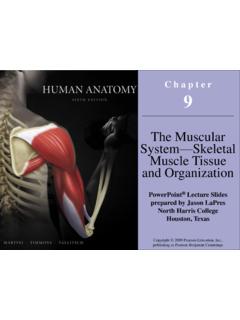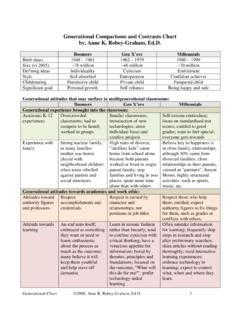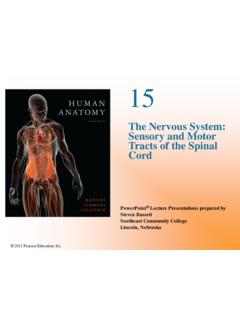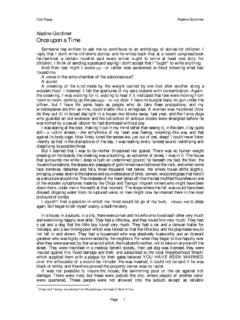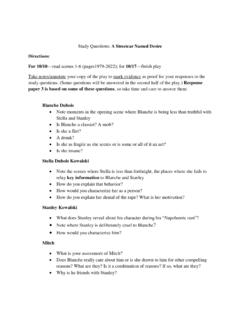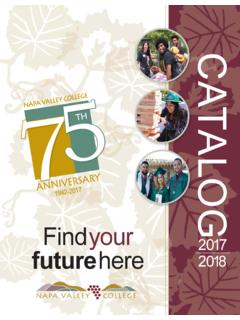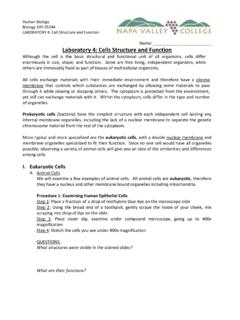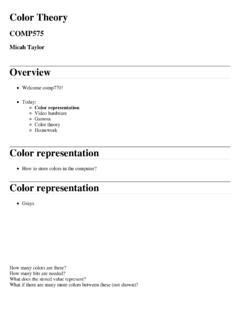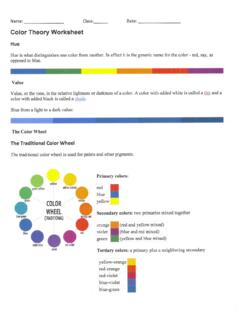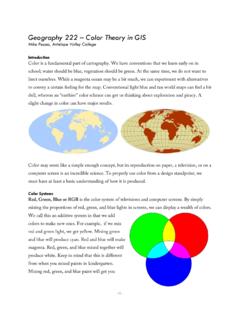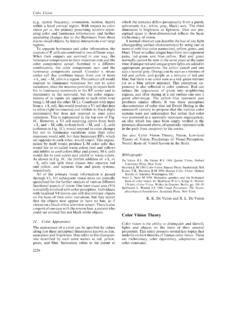Transcription of ARTS 105 Color theory syllabus fall 2014 - Napa Valley College
1 Napa Valley College arts 105 Color theory Fall 2014 syllabus Mondays and Wednesdays 9:30 AM-12:20 PM Fain Hancock COURSE INFORMATION COURSE DESCRIPTION: This course focuses on the principles, theories, and applications of additive and subtractive Color in two dimensions. Topics will include major historical and contemporary Color systems, production of projects in applied Color , and the elements of design as they apply to Color . STUDENT LEARNING OUTCOMES 1. Produce a portfolio of finished Color projects that demonstrates competency in basic Color theory and design application.
2 2. Critique artwork and receive criticism from others. COURSE OBJECTIVES: By the end of the semester it is expected the student will be able to: 1. Create aesthetically complete designs and images that demonstrate a working knowledge of: Color systems and Color organization Principles of Color perception - light, vision, and how the brain processes Color Value, hue, intensity (chroma), and Color temperature Additive and subtractive Color (light and paint) Relationships between Color and composition Color usage in contemporary art and design; 2. Make individual aesthetic decisions and judgments related to their own artwork; 3.
3 Skillfully use a variety of artistic materials, techniques and tools; 4. Independently produce finished Color assignments that demonstrate an understanding of Color theory and principles in the history of art; 5. Comprehend and describe how Color is perceived biologically, psychologically, culturally, symbolically and intuitively. COURSE CONTENT 1. History of Color and the development of the Color palette. 2. Color systems and Color organization. 3. The perception of Color - light, vision, and how the brain. 4. Value, hue, intensity (chroma), and Color temperature. 5. Colors, palettes and materials.
4 6. Additive and subtractive Color (light and paint). 7. Color and composition. 8. Identifying and understanding Color mixtures. 9. Cultural influences on Color usage. 10. Color usage in contemporary art and design. 11. Color and Technology 12. Critical evaluation and critique of class projects. COURSE STRUCTURE: This is a studio class. Most of our time is used for studio production and practice. You are expected to come prepared with the necessary supplies for serious, sustained work. You are expected to complete work begun in class outside of class. The art studios are available for students to use when there are no classes scheduled.
5 READING: Color a Workshop Approach by David Hornung; Laurence King Publishing; 2 edition (September 5, 2012)second edition Used copies are available online at and At Chegg you can rent this text. ATTENDANCE AND CONDUCT: Students who miss more than two class periods without documentation excusing their absences or who fail to arrange their absences in advance could be dropped from the course. Art making requires consistent, focused engagement. Be fully present and ready to work hard. Your success in this class is dependent on your sustained, sincere efforts. Cell phones, iPods and other electronic devices are not allowed during class time unless being used for research.
6 GRADING Grading will be on based finished projects, written assignments and participation in critiques. You will be graded for effort, technical and conceptual growth and completeness. The final grade will be based on the following percentages: FINAL GRADE CLASS PROJECTS collage Color wheel Mixing your primary and secondary colors Creating a 12 Color wheel gray scale tints, shades, tones saturation continuum Assignment 1a and 1b Chromatic Gray Studies, page 50 Assignment 2a and 2b Muted Color Studies, page 52 Assignment 3 Prismatic Studies, page 54 Assignment 4 Combined Saturation Studies, page 55.
7 Assignment 5a and 5b Interaction Studies, page 67-68 Assignment 5d, page 69 Interaction Composition, page 71 Painting your skin tones Assignment 7a and 7b: Color Progression studies, page 80 Water glass studies, page 89 Illusions of Transparency and Space, page 84 Assignment 7a and 7b: Color Progression studies, page 80 Assignment 10a and 10 Two Color Complementary Palette, pages 101-102 Assignment 11a,11b and 11c Intermix Dot Inventories Assignment 12a, 12b and 12c Compositions with Color Admixtures, page 105 Assignment 13 Proportional Color Inventory, page113 Assignment 14 Nonproportional Color Inventory, page 117 70% FINAL PROJECT applied vocabulary 10% VOCABULARY, WRITING, RESEARCH, QUIZZES Gallery Report.
8 Descriptive Essay of a work of art viewed during the di Rosa field trip applied vocabulary quizzes Other written assignments 10% Preparation, class participation, studio/facility maintenance See attached rubric for explanation 10% Projects and writing assignments will be accepted up to one week late. However, you cannot receive full credit for a late project. Late projects will be lowered at least one or more letter grade. Please talk to me if you are having problems completing the work. CONTACT INFORMATION: Fain Hancock 3715-B 707 256 7534 office 707 738 6708 text Students in need of accommodations in the College learning environment: Any student who feels s/he may need an accommodation based on the impact of a learning disability should contact Learning Services in the Library and Learning Resource Center (LLRC), room 1766, phone (707) 256-7442.
9 A Learning Disability Specialist will review your needs and determine appropriate accommodations. If you need accommodations for physical or other types of disabilities, schedule an appointment with DSPS Counselor, Sheryl Fernandez, in the Counseling Department located in the 1300 building, phone (707) 256-7220 for appointment. All information and documentation is confidential. Please feel encouraged to make an appointment with me privately to discuss your specific learning needs in my class. Some NVC students, staff, and faculty are seriously impaired by environmental illness or Immune Dysfunction Syndrome.
10 They can experience breathing problems, headaches, sudden fatigue, mood swings, or memory lapses when exposed to perfumes, soaps, scented sprays or lotions, chemicals, tobacco smoke, or dust. Your sensitivity to the problem is extremely important. By minimizing the use of strongly scented soaps, perfumes, and other products, we can help those affected. arts -105 Color theory Fall 2014 Weekly Schedule Mondays and Wednesdays 9:30 AM-12:20 PM Fain Hancock PART ONE: SEEING Color Week 1: Introduction, Science of Color Monday, August 18 Introduction to arts 105, where to purchase supplies, textbook, course expectations Science of Color , additive and subtractive Color , pigment Color mixing of co-primary colors Wednesday, August 20: Project: Collage Color wheel.
